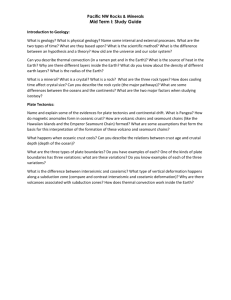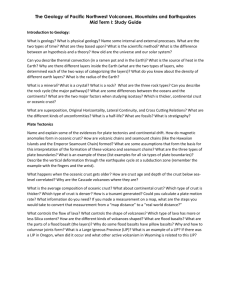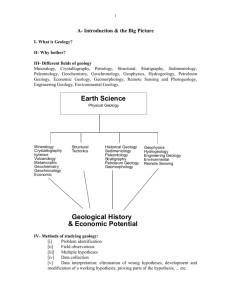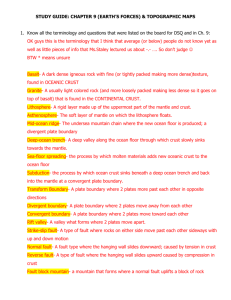GEO144_mid_term_I_st..
advertisement
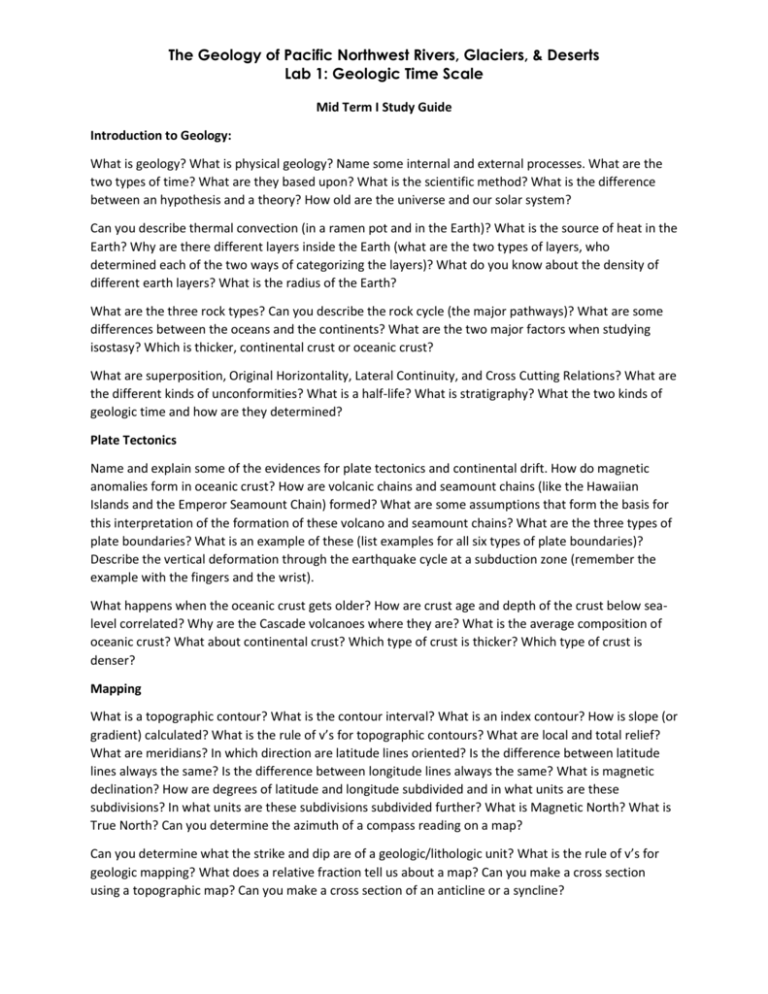
The Geology of Pacific Northwest Rivers, Glaciers, & Deserts Lab 1: Geologic Time Scale Mid Term I Study Guide Introduction to Geology: What is geology? What is physical geology? Name some internal and external processes. What are the two types of time? What are they based upon? What is the scientific method? What is the difference between an hypothesis and a theory? How old are the universe and our solar system? Can you describe thermal convection (in a ramen pot and in the Earth)? What is the source of heat in the Earth? Why are there different layers inside the Earth (what are the two types of layers, who determined each of the two ways of categorizing the layers)? What do you know about the density of different earth layers? What is the radius of the Earth? What are the three rock types? Can you describe the rock cycle (the major pathways)? What are some differences between the oceans and the continents? What are the two major factors when studying isostasy? Which is thicker, continental crust or oceanic crust? What are superposition, Original Horizontality, Lateral Continuity, and Cross Cutting Relations? What are the different kinds of unconformities? What is a half-life? What is stratigraphy? What the two kinds of geologic time and how are they determined? Plate Tectonics Name and explain some of the evidences for plate tectonics and continental drift. How do magnetic anomalies form in oceanic crust? How are volcanic chains and seamount chains (like the Hawaiian Islands and the Emperor Seamount Chain) formed? What are some assumptions that form the basis for this interpretation of the formation of these volcano and seamount chains? What are the three types of plate boundaries? What is an example of these (list examples for all six types of plate boundaries)? Describe the vertical deformation through the earthquake cycle at a subduction zone (remember the example with the fingers and the wrist). What happens when the oceanic crust gets older? How are crust age and depth of the crust below sealevel correlated? Why are the Cascade volcanoes where they are? What is the average composition of oceanic crust? What about continental crust? Which type of crust is thicker? Which type of crust is denser? Mapping What is a topographic contour? What is the contour interval? What is an index contour? How is slope (or gradient) calculated? What is the rule of v’s for topographic contours? What are local and total relief? What are meridians? In which direction are latitude lines oriented? Is the difference between latitude lines always the same? Is the difference between longitude lines always the same? What is magnetic declination? How are degrees of latitude and longitude subdivided and in what units are these subdivisions? In what units are these subdivisions subdivided further? What is Magnetic North? What is True North? Can you determine the azimuth of a compass reading on a map? Can you determine what the strike and dip are of a geologic/lithologic unit? What is the rule of v’s for geologic mapping? What does a relative fraction tell us about a map? Can you make a cross section using a topographic map? Can you make a cross section of an anticline or a syncline? The Geology of Pacific Northwest Rivers, Glaciers, & Deserts Lab 1: Geologic Time Scale Rocks, Minerals, and Weathering What are the sub-atomic particles, how are they configured, what are their charges? What is the atomic number? What is an ion? What is an isotope? What is a chemical compound and do you know an example? What is a mineral? What are the three different principal properties (and examples of each) that people use to identify minerals? What is a rock? How do the three different types of bonds form? What is a silica tetrahedron? What the different forms of silicates and examples of each? How do these forms relate to the discontinuous Bowens Reaction Series? What is the composition variation that leads to the continuous Bowens Reaction Series? What are some relations shown on the Bowens Reaction Series plot? What are the two kinds of Weathering and what are some examples of each?
